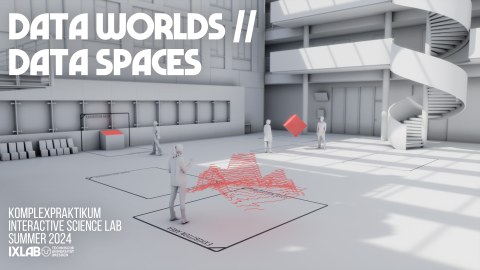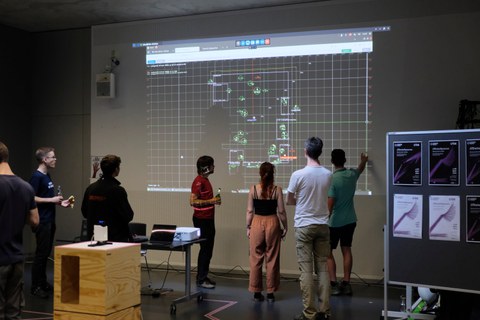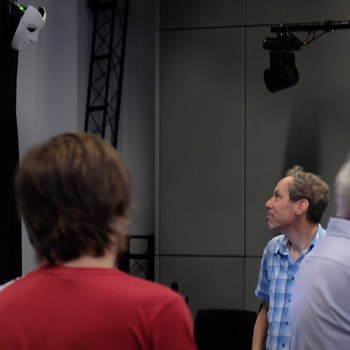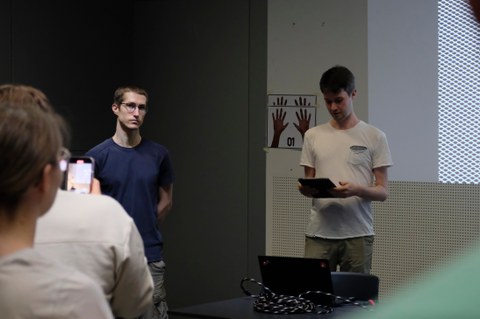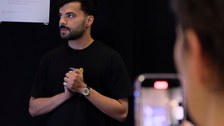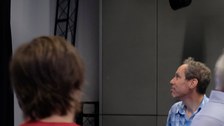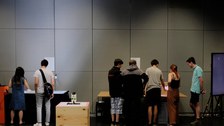DataWorlds // DataSpaces
In the winter semester 2024/25, the Andreas-Pfitzmann-Bau will become an exhibition space. The exhibition "DataSpaces" will be shown in the foyer for around 8 weeks, offering a fascinating insight into the research topics at TU Dresden. One focus is on topics such as complexity and machine learning, which represent an important part of current research. The exhibition aims to combine current research findings with historical objects and artistic works and offer visitors an interactive experience. In the KP, we are developing various exhibits that make these topics tangible in a variety of ways. The range of design options extends from screen-based stations to haptic-reactive objects.
The development process is accompanied by excursions and lectures. The focus of the CP is the development of functional exhibits, which will then actually be presented in the exhibition.
Results
Chatbots
by Hendrik Appel and Karam AL-Janabi
Chatbots was motivated by the desire to make complex topics in science, technology, and society more accessible and engaging. It features an interactive AI-driven system where users can converse with virtual agents, each representing different thematic aspects like knowledge, morality, and arts. Utilizing advanced technologies such as Speech-to-Text and Large Language Models, the system facilitates natural, educational dialogues. The goal is to foster curiosity and understanding through relatable and dynamic interactions, making learning both informative and entertaining.
Data Tracks
by Lukas Luger, Simon Minch and Verena Well
© Lukas Luger, Simon Minch, Verena Well
The amount of data that is collected online about an individual is used in a variety of ways, e.g. for targeted advertising, mass surveillance or even to influence politics. Although we know about this, many people still do not consider privacy in their daily lives. The Data Tracks exhibit was developed to highlight the importance of privacy and security. Data Tracks aims to give visitors a brief overview of their viewing and visiting habits. LiDAR sensors are installed throughout the exhibition to track and record visitors' movements. This also includes the time visitors spend at each exhibit. Their path is then displayed on a large screen. The visit times result in an interest profile, which is displayed as a graphic. An AI-generated short text comments on the profile in a (hopefully) humorous way.
Faces
by Leon Georgi and Robert Ludwig
© Leon Georgi, Robert Ludwig
In present times, it is commonplace for various technologies to observe different aspects of our lives. This surveillance can take place through our own mobile phones, but also through more external devices, e.g. in public spaces. While this observation has both positive and negative implications, people often remain unaware that this is happening.
Faces is designed to create a moment of surprise and realization for visitors and illustrate the presence of surveillance. At the heart of the exhibit are moving masks that are attached to the walls and rotate to observe visitors as they pass by. This is achieved by a LiDAR system that scans the entire exhibition space for visitors and calculates their position. The system then sends this data to a small single-board computer behind the mask, which then determines the appropriate viewing angle and adjusts the orientation of the mask accordingly.
Tangible Computing - Retro Reboot
by Eddy Loose and Lorenz Hoffmann
One of the first desktop computers was the D4A, designed in the 1960s by Professor Nikolaus Joachim Lehmann at the TU Dresden.
One method of connecting to this machine, including data entry and programming, was the use of punched tape. Code was physically generated with these punched strips and interpreted by the desktop computer.
Tangible Computing - Retro Reboot offers the possibility to generate code yourself by punching a punched strip and having it interpreted in various ways, whether as animation, calculation instructions or as drum computer input.
Build-A-Server
by Lukas Nawka and Jonathan Pitzschel
© Lukas Nawka, Jonathan Pitzschel
The purpose of Build-A-Server is to give people who are not familiar with high performance computing (or computer hardware in general) a simple overview of the various essential components of a server. Physical building blocks represent the individual hardware modules of a server and can be attached to a magnetic base. The exhibit registers the attachment and provides information about the individual components. In addition, different hardware components can be combined to solve playful tasks.
Orte der Informatik
by Yenong Zhang and Bulat Fakhrutdinov
© Yenong Zhang, Bulat Fakhrutdinov
Orte der Informatik is an interactive exhibit that invites visitors to explore important computer science locations in Dresden. Using a touchscreen interface, visitors can guide the pixel figures on a virtual tour and discover important places associated with Dresden's rich history and culture in computer science. As users navigate through the map, they receive insightful information about each location, combining education with entertainment.
Betreuung
Brian Eschrich
Monika Reich
Kelsang Mende
Jun.Prof. Matthew McGinity

